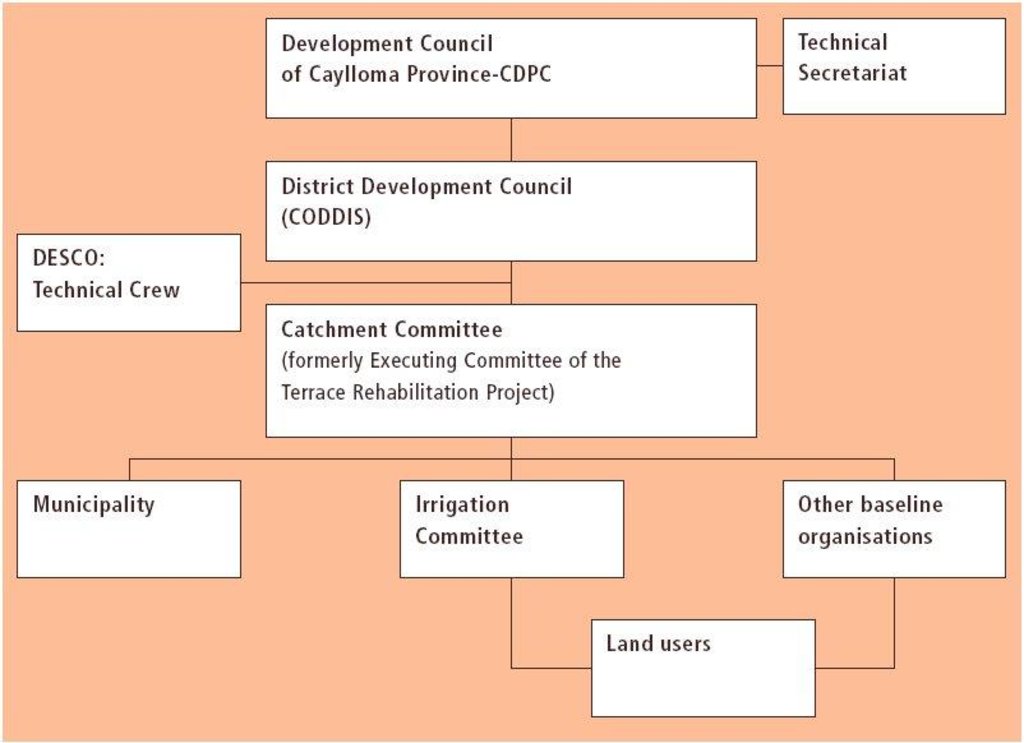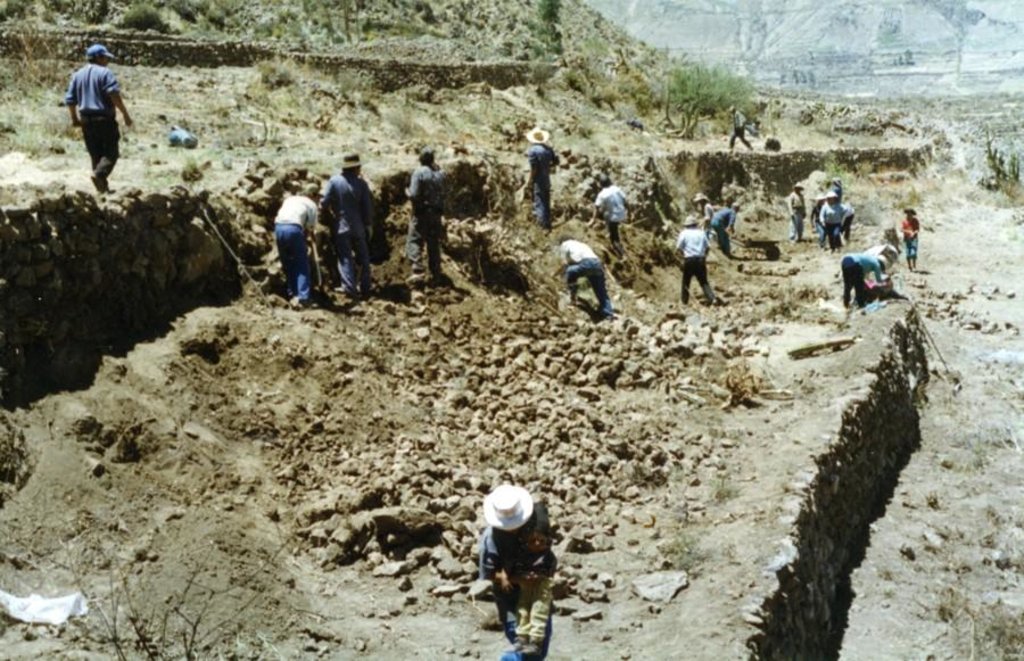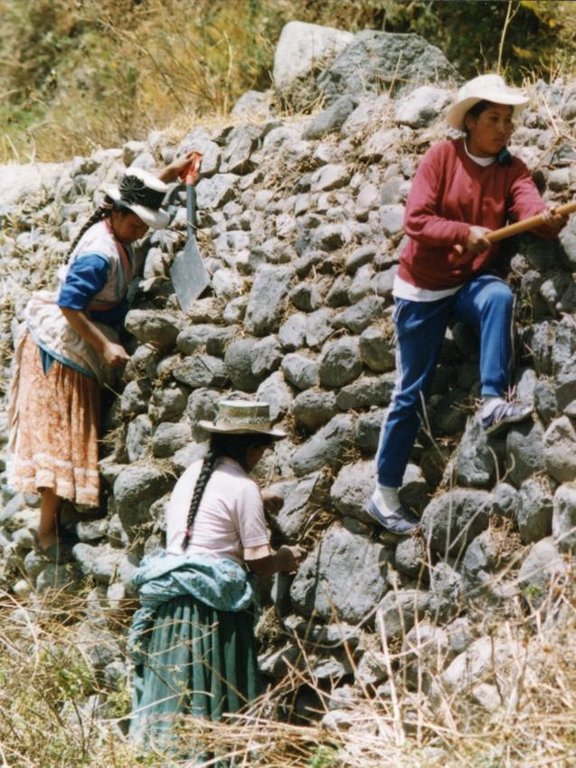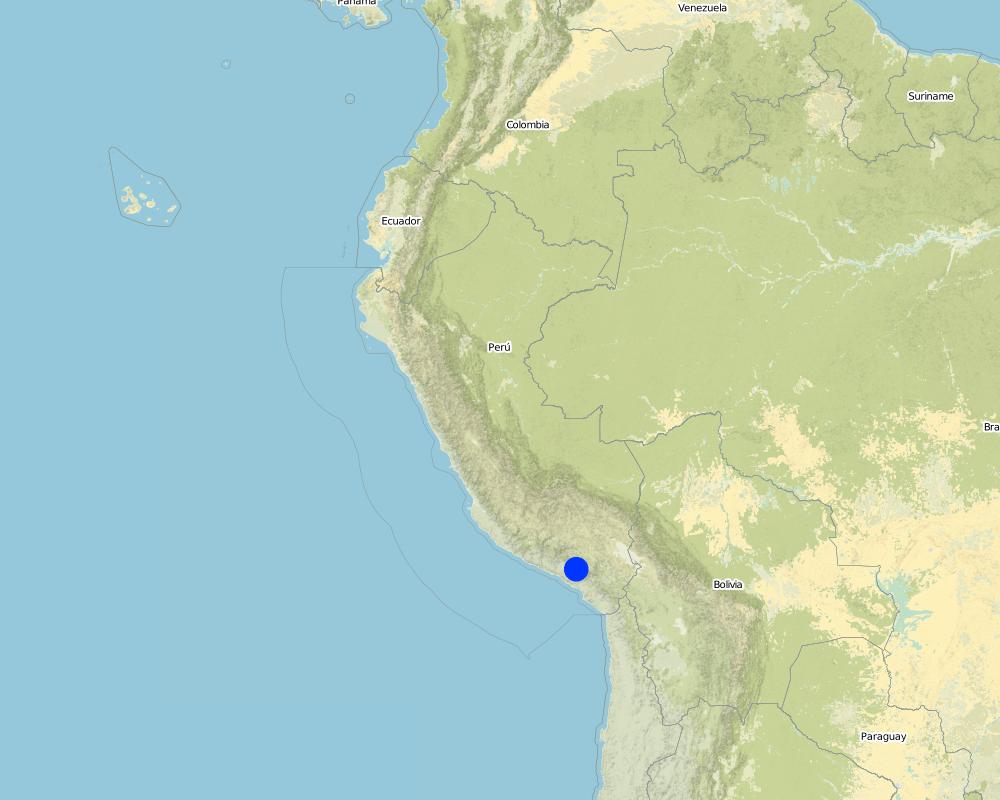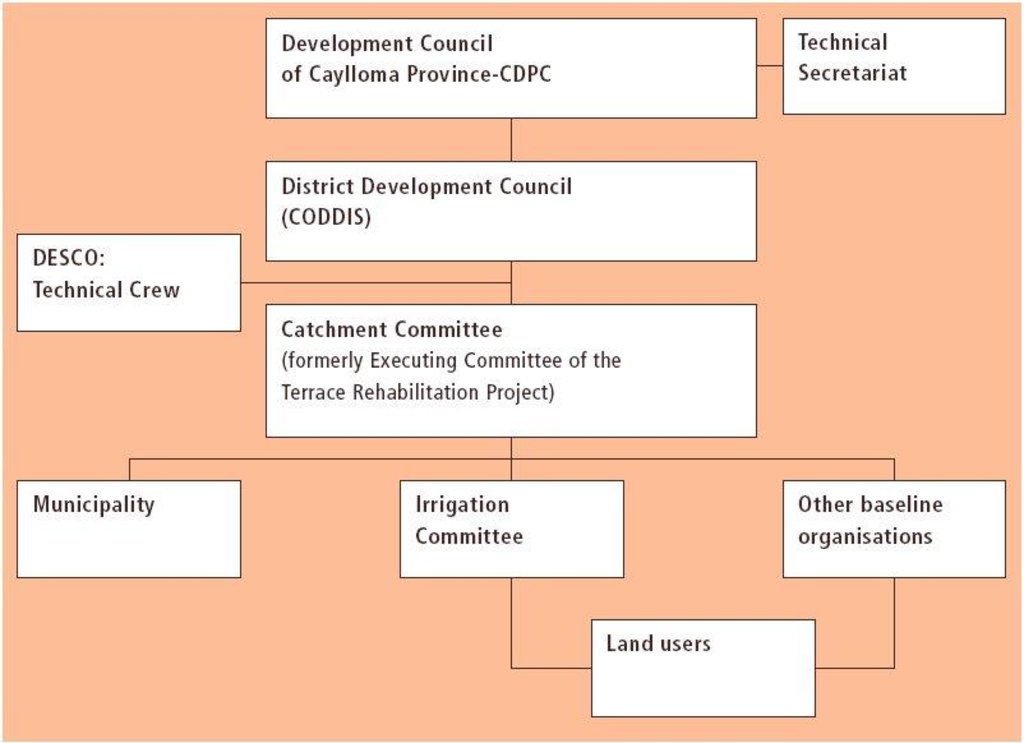Participatory catchment rehabilitation (Participación comunitaria para la rehabilitación de cuencas) [เปรู]
- ผู้สร้างสรรค์:
- การอัพเดท:
- ผู้รวบรวม: Philippe Zahner
- ผู้เรียบเรียง: –
- ผู้ตรวจสอบ: Fabian Ottiger, Deborah Niggli
approaches_2347 - เปรู
ดูส่วนย่อย
ขยายทั้งหมด ย่อทั้งหมด1. ข้อมูลทั่วไป
1.2 รายละเอียดที่ติดต่อได้ของผู้รวบรวมและองค์กรที่เกี่ยวข้องในการประเมินและการจัดเตรียมทำเอกสารของแนวทาง
ผู้เชี่ยวชาญ SLM:
Marquina Rodolfo
descolca@terra.com.pe
Centro de Estudios y Promocion del Desarrollo - DESCO
Calle Malaga Grenet No. 678 Umacollo, Arequipa
เปรู
ผู้เชี่ยวชาญ SLM:
Marcacuzco Aquilino P Mejia
Centro de Estudios y Promocion del Desarrollo - DESCO
Calle Malaga Grenet No. 678 Umacollo, Arequipa
เปรู
ชื่อของโครงการซึ่งอำนวยความสะดวกในการทำเอกสารหรือการประเมินแนวทาง (ถ้าเกี่ยวข้อง)
Book project: where the land is greener - Case Studies and Analysis of Soil and Water Conservation Initiatives Worldwide (where the land is greener)ชื่อของโครงการซึ่งอำนวยความสะดวกในการทำเอกสารหรือการประเมินแนวทาง (ถ้าเกี่ยวข้อง)
Swiss Agency for Development and Cooperation (DEZA / COSUDE / DDC / SDC) - สวิตเซอร์แลนด์ชื่อของโครงการซึ่งอำนวยความสะดวกในการทำเอกสารหรือการประเมินแนวทาง (ถ้าเกี่ยวข้อง)
Centro de Estudios y Promoción del Desarrollo (DESCO) - เปรู1.3 เงื่อนไขที่เกี่ยวข้องกับการใช้ข้อมูลที่ได้บันทึกไว้ผ่านทาง WOCAT
ผู้รวบรวมและวิทยากรหลักยอมรับเงื่อนไขเกี่ยวกับการใช้ข้อมูลที่ถูกบันทึกผ่านทาง WOCAT:
ใช่
1.4 การอ้างอิงถึงแบบสอบถามเรื่องเทคโนโลยี SLM
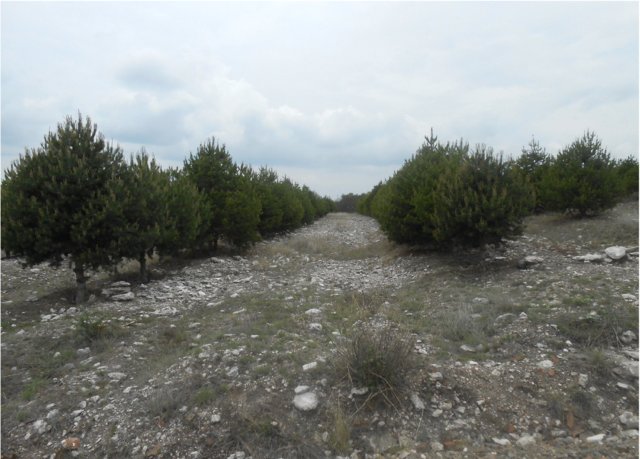
Callejones de piñón con forrajes intercalados [เม็กซิโก]
La tecnología consiste en un sistema agrosilvopastoril con árboles de Pinus cembroides (pino piñonero) alineados een bordos ─en un terreno con suelos calizos previamente subsoleado─ conformando melgas (callejones) para con cultivos anuales para grano y forraje, con pastoreo libre eventual por períodos muy breves.
- ผู้รวบรวม: BENJAMIN SANCHEZ BERNAL
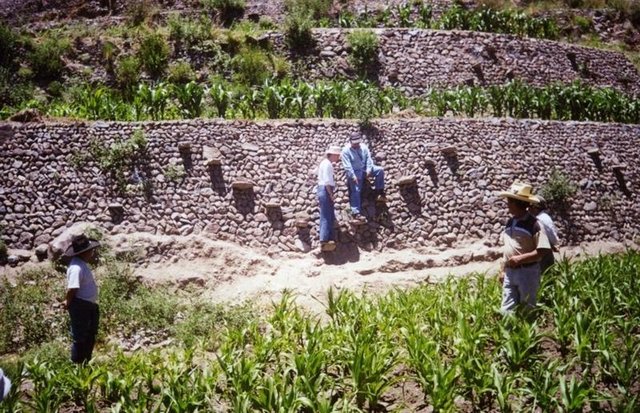
Rehabilitation of ancient terraces [เปรู]
Repair of ancient stone wall bench terraces, and of an associated irrigation and drainage system.
- ผู้รวบรวม: Unknown User
2. คำอธิบายของแนวทาง SLM
2.1 การอธิบายแบบสั้น ๆ ของแนวทาง
Promoting the rehabilitation of ancient terrace systems based on a systematic watershed management approach.
2.2 การอธิบายอย่างละเอียดของแนวทาง
การอธิบายอย่างละเอียดของแนวทาง:
Aims / objectives: The Center for Studies and Promotion of Development - DESCO, a Peruvian NGO, started the Terrace Rehabilitation Project in 1993 to re-establish ancient terracing and irrigation practices that had largely been lost. The project is part of a general integrated development programme. Its overall purpose is to restore the productive capacity of terraced cropland, and to generate better living standards in the Colca valley. The project has the following specific objectives: (1) to increase the productive infrastructure through soil conservation and better use and management of existing water resources; (2) to increase levels of production; (3) to stimulate people in soil conservation and land management; and (4) to encourage/promote relevant local institutions. For implementation, a systematic watershed management approach was introduced. The catchment was considered the basic unit for development planning. Physical and socio-economic baseline studies were carried out. A strong community-based organisation, the catchment committee, was then founded. This consisted of representatives of major local grassroots organisations (irrigation committee, farmers' community, mothers' club etc). Responsibilities, commitments and rules were defined. Committee meetings and land user assemblies were the entities for planning, organisation and execution of project activities. DESCO initiated a process of 'concerted planning' in collaboration with other private and public institutions in Caylloma province.
Methods: In summary the project stages comprised: (1) project planning; (2) baseline studies; (3) catchment management plan; (4) constitution of the executive committee; (5) concerted planning of district development; and (6) organisation, execution, technical assistance and follow-up activities. Land users were required to participate in training courses and in fieldwork, to provide local materials and their own tools, and to fulfil duties within the organisations. Leaders and directors of grassroots organisations were responsible for planning and organisation of activities - implementation, training and follow-up - and for control and administration of project materials and inputs. The directors were also elected as representatives in the District Development Councils to participate in the evaluation and monitoring activities of the project.
2.3 รูปภาพของแนวทาง
2.5 ประเทศ ภูมิภาค หรือสถานที่ตั้งที่ได้นำแนวทางไปใช้
ประเทศ:
เปรู
ภูมิภาค/รัฐ/จังหวัด: :
Rio Colca
ข้อมูลเฉพาะเพิ่มเติมของสถานที่ตั้ง:
Arequipa, Peru
Map
×2.6 วันที่เริ่มต้นและสิ้นสุดของแนวทาง
ระบุปีที่เริ่ม:
1993
2.7 ประเภทของแนวทาง
- ใช้โครงงานหรือแผนงานเป็นฐาน
2.8 เป้าหมายหรือวัตถุประสงค์หลักของแนวทาง
- to achieve higher levels of agricultural production and productivity through integrated development/management of soil and water resources. - to build capacity for planning, organisation and implementation of development activities
The SLM Approach addressed the following problems: - lack of employment opportunities/depopulation of rural areas. - lack of planning and action in 'concerted development' - little value associated with terrace rehabilitation. - low and unequal participation of women in field work. - general impoverishment of land users
2.9 เงื่อนไขที่เอื้ออำนวยหรือเป็นอุปสรรคต่อการนำเทคโนโลยีภายใต้แนวทางนี้ไปปฏิบัติใช้
บรรทัดฐานและค่านิยมทางสังคม วัฒนธรรม ศาสนา
- เป็นอุปสรรค
Women were treated unequally in terms of opportunities and salaries
Treatment through the SLM Approach: Equal treatment in salaries and better opportunities were ensured for women.
การมีไว้ให้หรือการเข้าถึงแหล่งการเงินและบริการ
- เป็นอุปสรรค
The poorest land users lacked the money to invest in terrace rehabilitation.
Treatment through the SLM Approach: Manual labour and tools were subsidised.
การจัดตั้งระดับองค์กร
- เป็นอุปสรรค
Coordination of planning and activities was lacking between different institutions and projects.
Treatment through the SLM Approach: District Development Councils (CODDIS) were strengthened as entities for coordination and concerted action.
กรอบแนวทางในการดำเนินการด้านกฎหมาย (การถือครองที่ดิน สิทธิในการใช้ที่ดินและน้ำ)
- เป็นอุปสรรค
There was a lack of legal (registered) institutions to coordinate planning and strategies for sustainable land use at community level.
Treatment through the SLM Approach: An active effort was made to promote legalisation of, and give support to, grassroots organisations (eg Union of Land Users).
ความรู้เกี่ยวกับ SLM การเข้าถึงการสนับสนุนด้านเทคนิค
- เป็นอุปสรรค
Local specialists in terrace rehabilitation and for construction supervision were lacking.
Treatment through the SLM Approach: Training and competitions were organised to develop skills and select the best.
อื่นๆ
- เป็นอุปสรรค
Economical: Investment in cash crops was a problem for poor smallholders.
Treatment through the SLM Approach: Training/technical assistance was given for more profitable crops e.g potatoes, beans and peas.
3. การมีส่วนร่วมและบทบาทของผู้มีส่วนได้ส่วนเสียที่เกี่ยวข้อง
3.1 ผู้มีส่วนได้ส่วนเสียที่เกี่ยวข้องในแนวทางนี้และบทบาท
- ผู้ใช้ที่ดินระดับท้องถิ่นหรือชุมชนระดับท้องถิ่น
There were no differences in terms of salaries, but there were in terms of job opportunities: in a working group of 20 persons, typically only 5 women were contracted as terrace rehabilitation is very heavy work.
- ผู้เชี่ยวชาญ SLM หรือที่ปรึกษาการเกษตร
- ครู เด็กนักเรียน หรือนักศึกษา
- รัฐบาลแห่งชาติ (ผู้วางแผน ผู้ทำการตัดสินใจ)
3.2 การเกี่ยวข้องของผู้ใช้ที่ดินระดับท้องถิ่นหรือชุมชนระดับท้องถิ่นในช่วงต่างๆของแนวทาง
| ความเกี่ยวข้องของผู้ใช้ที่ดินระดับท้องถิ่นหรือชุมชนระดับท้องถิ่น | ระบุผู้ที่มีส่วนเกี่ยวข้องและอธิบายกิจกรรม | |
|---|---|---|
| การริเริ่มหรือการจูงใจ | ปฏิสัมพันธ์ | interviews/questionnaires, workshops/seminars, public meetings |
| การวางแผน | ระดมกำลังด้วยตนเอง | workshops/seminars; assemblies for decision making, workshops for local concerted planning |
| การดำเนินการ | ปฏิสัมพันธ์ | casual labour, responsibility for minor steps; casual labour, responsibility for minor steps (land users in general); responsibility for major steps (leaders) |
| การติดตามตรวจสอบหรือการประเมินผล | ปฏิสัมพันธ์ | workshop/seminars, reporting, measurements/observations, interviews/questionnaires, public meetings; workshops, measurements/observations (directors of baseline organisations/leaders), reports (directors), interviews (directors/teachers), public meetings (land users) |
| Research | ไม่มี | none |
3.3 แผนผังแสดงขั้นตอนการทำงาน (ถ้ามี)
คำอธิบาย:
District Development Council (CODDIS): social organisations, public and private institutions jointly prepare economic and social development plans in a participatory manner, and under the leadership o
3.4 การตัดสินใจเลือกใช้เทคโนโลยี SLM
ระบุผู้ที่ทำการตัดสินใจเลือกเทคโนโลยีมากกว่าหนึ่งวิธีไปปฏิบัติใช้:
- ผู้เชี่ยวชาญ SLM เป็นผู้ตัดสินใจหลัก ที่ติดตามให้คำปรึกษากับผู้ใช้ที่ดิน
การอธิบาย:
the terraces were in an advanced stage of collapse and the local population did not have the means to reverse the process due to lack of economic resources.
Decisions on the method of implementing the SLM Technology were made by mainly by land users supported by SLM specialists. the technology is indigenous and adapted to the area. Evaluation workshops of, and activities permitting discussions on, the technology were carried out.
4. การสนับสนุนด้านเทคนิค การสร้างขีดความสามารถ และการจัดการด้านความรู้
4.1 การสร้างขีดความสามารถ / การอบรม
ได้มีการจัดอบรมให้แก่ผู้ใช้ที่ดินหรือผู้มีส่วนได้ส่วนเสียคนอื่น ๆ หรือไม่:
ใช่
รูปแบบการอบรม:
- จัดการประชุมสู่สาธารณชน
รูปแบบการอบรม:
- exchange of experiences
หัวข้อที่พูด:
A training plan at three levels was drawn up, addressing the following target groups and topics: (1) Selected land users, leaders, supervisors: in-depth training on the interrelations between water, soil and plants; terrace and canal construction; institution/enterprise management; natural resource management, conservation practices, and crop production. (2) Directors of grassroots organisations
4.2 การบริการให้คำแนะนำ
ผู้ใช้ที่ดินมีการเข้าถึงการรับบริการให้คำปรึกษาหรือไม่:
ใช่
การอธิบาย/แสดงความคิดเห็น:
Key elements: technical assistance and sustained follow-up, supervision by specialised engineers, evaluation (reflection) and systematisation of gained know-how and developed practices with different stakeholders, function; testing of rehabilitated structures; Capacity for extension continuation has been built up within the catchment committee. However PRONAMACHS, a governmental SWC programme, is limited
4.3 การเสริมความแข็งแกร่งให้กับสถาบัน (การพัฒนาองค์กร)
สถาบันได้รับการจัดตั้งขึ้นมาหรือเสริมความแข็งแกร่งโดยแนวทางนี้หรือไม่:
- ใช่ อย่างมาก
ระบุระดับของสถาบันที่ได้รับการเสริมความแข็งแกร่งหรือจัดตั้งขึ้นมา:
- ท้องถิ่น
ระบุประเภทของการให้ความช่วยเหลือสนับสนุน:
- ด้านการเงิน
- การสร้างขีดความสามารถ / การอบรม
4.4 การติดตามตรวจสอบและประเมินผล
การติดตามตรวจสอบและประเมินผลเป็นส่วนหนึ่งของแนวทางหรือไม่:
ใช่
ความคิดเห็น:
technical aspects were regular monitored by 0 through measurements; indicators: improved structures, results of technology tests
socio-cultural aspects were ad hoc monitored by 0 through observations; indicators: land users changing attitudes of SWC
economic / production aspects were ad hoc monitored by 0 through measurements; indicators: crop production increase
area treated aspects were regular monitored by 0 through measurements; indicators: rehabilitated area
no. of land users involved aspects were regular monitored by 0 through measurements; indicators: number of households that benefited directly
management of Approach aspects were ad hoc monitored by 0 through observations; indicators: number of catchments rehabilitated with terraces and agroforestry
There were several changes in the Approach as a result of monitoring and evaluation: There were various changes/readjustments of the approach: eg the concerted planning through the Local Development Councils was incorporated 5 years after the initiation of the project.
4.5 การวิจัย
การวิจัยเป็นส่วนหนึ่งของแนวทางหรือไม่:
ใช่
ระบุหัวข้อเรื่อง:
- เศรษฐศาสตร์หรือการตลาด
- เทคโนโลยี
ให้ข้อมูลเพิ่มเติมและให้ระบุผู้ทำการวิจัย:
Technology: research has been ongoing regarding functioning of the terrace and irrigation systems. Economy/commercialisation: research regarding agronomic production, catchment appraisals and market studies have been carried out for the main products of the area.
5. การสนับสนุนด้านการเงินและวัสดุอุปกรณ์
5.1 ระบุงบประมาณประจำปีสำหรับแนวทาง SLM นี้
แสดงความคิดเห็น (แหล่งของการระดมทุน ผู้บริจาคคนสำคัญ):
Approach costs were met by the following donors: international non-government (International NGO): 60.0%; government (national): 20.0%; local community / land user(s) (-): 20.0%
5.2 การสนับสนุนด้านการเงิน / วัสดุอุปกรณ์ให้แก่ผู้ใช้ที่ดิน
ผู้ใช้ที่ดินได้รับการสนับสนุนด้านการเงิน / วัสดุอุปกรณ์ไปปฏิบัติใช้เทคโนโลยีหรือไม่:
ใช่
5.3 เงินสนับสนุนสำหรับปัจจัยนำเข้า (รวมถึงแรงงาน)
- อุปกรณ์
| ระบุปัจจัยนำเข้าที่ได้รับการสนับสนุน | เห็นด้วยระดับไหน | ระบุเงินสนับสนุน |
|---|---|---|
| เครื่องจักร | ได้รับการช่วยเหลือทางการเงินบางส่วน | A-frames, tape measures, motor drills, wheelbarrows, shovels, picks, steel bars, sledgehammers,hoes, and compressors |
| เครื่องมือ | ได้รับการช่วยเหลือทางการเงินบางส่วน | |
- การเกษตร
| ระบุปัจจัยนำเข้าที่ได้รับการสนับสนุน | เห็นด้วยระดับไหน | ระบุเงินสนับสนุน |
|---|---|---|
| เมล็ด | ได้รับการช่วยเหลือทางการเงินแบบเต็ม | Seedlings of tree species for establishment of the agroforestry component on terraces were produced in a project-owned nursery, and they were given free of charge to interested farmers |
ถ้าแรงงานโดยผู้ใช้ที่ดินเป็นปัจจัยนำเข้าที่มีอยู่มากมาย ระบุด้วยว่าเนื่องจาก:
- จ่ายเป็นเงินสด
ความคิดเห็น:
60% of the labour costs were met by the project.
5.4 เครดิต
มีการจัดหาเครดิตมาให้ภายใต้แนวทาง SLM หรือไม่:
ใช่
ถ้าใช่ ระบุเงื่อนไข (อัตราดอกเบี้ย การชำระคืน):
repayment conditions: Credit was provided by FONDESURCO to land users who participated in the rehabilitation project (for seed supply) with a lower interest rate than on the market. FONDESURCO is an NGO (of which DESCO is a member) specialised in microfinances in the rural sector..
5.5 แรงจูงใจหรือเครื่องมืออื่น ๆ
แรงจูงใจหรือเครื่องมืออื่น ๆ ได้ถูกนำไปใช้ส่งเสริมการใช้เทคโนโลยี SLM หรือไม่:
ใช่
ถ้าใช่ ระบุ:
Support was provided to existing institutions (in the form of training, organisation and financial inputs). But with the formation of a catchment committee, an important grassroots organisation was built up.
6. การวิเคราะห์ผลกระทบและการสรุป
6.1 ผลกระทบของแนวทาง
ช่วยให้ผู้ใช้ที่ดินนำเอาเทคโนโลยี SLMไปใช้และบำรุงรักษาสภาพไว้ได้หรือไม่:
- ไม่ใช่
- ใช่ เล็กน้อย
- ใช่ ปานกลาง
- ใช่ อย่างมาก
There have been great improvements: introduction of high-value crops; 100% of the area cultivable; reduction of irrigation frequency by 20% due to higher efficiency of water storage by the terraces; various other SWC benefits.
Did other land users / projects adopt the Approach?
- ไม่ใช่
- ใช่ เล็กน้อย
- ใช่ ปานกลาง
- ใช่ อย่างมาก
A few other projects have adopted the approach: eg the project of the Banco de Vivienda PRATVIR in the Coporaque area; also 'Popular Cooperation' in Ichupampa (covering just 2 ha).
6.3 ความยั่งยืนของกิจกรรมของแนวทาง
ผู้ใช้ที่ดินสามารถทำให้สิ่งต่างๆ ที่ได้ปฏิบัติใช้โดยแนวทางนี้ยั่งยืนได้หรือไม่ (โดยไม่มีการสนับสนุนจากภายนอก):
- ใช่
ถ้าตอบว่าใช่ ให้อธิบายว่าอย่างไร :
Land users can continue the activities without external support, using traditional systems of mutual help and new forms of local organisation (catchment committee). With increased income through integration of cash crops the maintenance of the structures can be sustained.
6.4 จุดแข็งและข้อได้เปรียบของแนวทาง
| จุดแข็ง / ข้อได้เปรียบของแนวทางในทัศนคติของผู้รวบรวมหรือวิทยากรหลัก |
|---|
| Complementary conservation practices have been integrated into the terraces system: agroforestry, improved fallow, etc (How to sustain/ enhance this strength: Training of land users in the advantages and disadvantages of these practices.) |
| nstitutional capacity building: strengthening of organisations; increased participation (How to sustain/ enhance this strength: Continue the training of leaders.) |
| SWC training and extension activities. (How to sustain/ enhance this strength: Create spaces and mechanisms for daily practice of important cultural rituals/customs.) |
| 80% of land users have changed attitudes towards SWC, and are convinced of the benefits of terrace rehabilitation (How to sustain/ enhance this strength: SWC training and extension activities.) |
| Human capacity building: 60 specialists trained in rehabilitation technology (How to sustain/ enhance this strength: Create opportunities to ensure continuation of their work.) |
| An effective systematic watershed management approach applied at catchment level (How to sustain/ enhance this strength: Other projects/institutions should apply this approach.) |
| Soil conservation activities integrated in the plans of 'concerted development' (How to sustain/ enhance this strength: Strengthening of the Local Development Councils (CODDIS).) |
6.5 จุดอ่อน / ข้อเสียเปรียบของแนวทางและวิธีในการแก้ไข
| จุดอ่อน / ข้อเสียเปรียบในทัศนคติของผู้รวบรวมหรือวิทยากรหลัก | สามารถแก้ไขปัญหาได้อย่างไร |
|---|---|
| Labour overload in the family | Better planning of work at the household level. |
| The approach requires the participation of all social and political stakeholders - which is practically impossible | Strengthen the Local Development Councils (CODDIS). |
| The generation of income encourages the purchase of industrialised products | More training regarding consumption of local products. |
| The economic incentives provided by the project affected the existing reciprocal relationships (eg labour exchange) | Cash for work incentives are sometimes useful to overcome labour constraints due to depopulation. |
| Small holdings and land fragmentation are constraints for cost-effective agriculture | Accelerate the process of land consolidation and entitlement. |
| Changes in leadership interrupt planned processes (of activities) | Permanent training to encourage leadership qualities. |
| Lack of a crop and irrigation plan for better water management | Elaboration and application of a plan. |
7. การอ้างอิงและการเชื่อมต่อ
7.1 วิธีการหรือแหล่งข้อมูล
- ไปเยี่ยมชมภาคสนาม การสำรวจพื้นที่ภาคสนาม
- การสัมภาษณ์กับผู้ใช้ที่ดิน
ลิงก์และโมดูล
ขยายทั้งหมด ย่อทั้งหมดลิงก์

Callejones de piñón con forrajes intercalados [เม็กซิโก]
La tecnología consiste en un sistema agrosilvopastoril con árboles de Pinus cembroides (pino piñonero) alineados een bordos ─en un terreno con suelos calizos previamente subsoleado─ conformando melgas (callejones) para con cultivos anuales para grano y forraje, con pastoreo libre eventual por períodos muy breves.
- ผู้รวบรวม: BENJAMIN SANCHEZ BERNAL

Rehabilitation of ancient terraces [เปรู]
Repair of ancient stone wall bench terraces, and of an associated irrigation and drainage system.
- ผู้รวบรวม: Unknown User
โมดูล
ไม่มีโมดูล




